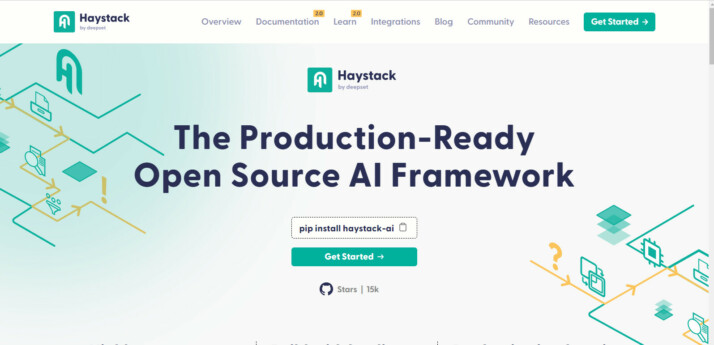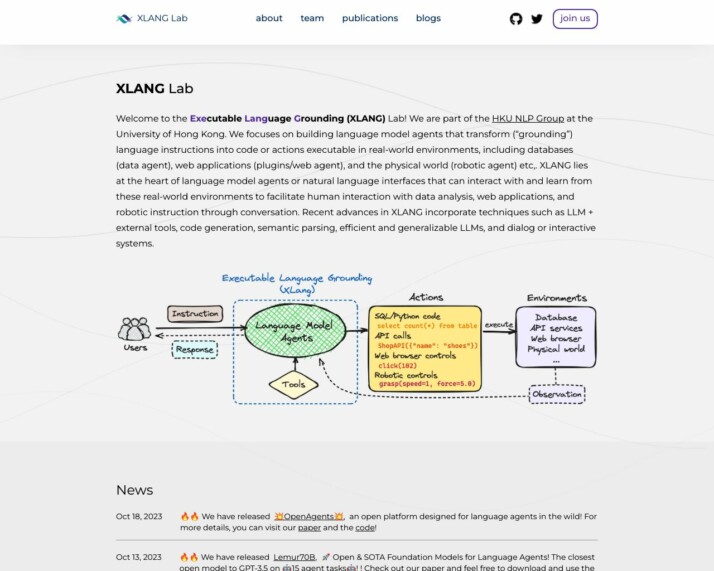Haystack vs. OpenAgents: Comparing AI Agent Development Platforms
AI agent development platforms have become essential tools for businesses and developers seeking to harness the power of artificial intelligence. In this comparison, we examine Haystack vs. OpenAgents, and SmythOS, three leading platforms that offer unique approaches to building AI-powered applications. Haystack provides a robust framework for NLP tasks, while OpenAgents focuses on specialized agents for everyday use. SmythOS emerges as a comprehensive solution, combining powerful features with user-friendly interfaces. This review explores each platform’s strengths, limitations, and ideal use cases, helping you determine which best suits your AI development needs.
Haystack Overview
Haystack empowers developers to build advanced AI applications using Large Language Models (LLMs) and vector search. This open-source framework excels in retrieval-augmented generation, document search, and question answering tasks.


Haystack’s modular architecture allows developers to create customized search experiences and chatbots by integrating tools like Hugging Face Transformers, Elasticsearch, and OpenAI into flexible pipelines. This versatility makes it suitable for a wide range of applications, from enhancing customer support to automating complex data analysis workflows.
Haystack’s modular architecture allows developers to create customized search experiences and chatbots by integrating tools… into flexible pipelines.
The framework supports the entire lifecycle of NLP application development through deepset Cloud, a commercial SaaS platform. This offering provides templates for common LLM setups, pre-built workflows, and collaborative tools for development teams. Haystack’s emphasis on scalability and production-readiness makes it an attractive option for businesses looking to deploy AI solutions at scale.
Haystack integrates seamlessly with popular AI models and databases, offering support for multimodal retrieval of texts, tables, and other content types. Its advanced features include AI agents capable of using tools to resolve complex queries, context-aware memory systems, and components for generating explainable AI outputs. These capabilities position Haystack as a powerful tool for developers seeking to create sophisticated, context-aware AI applications.
Haystack integrates seamlessly with popular AI models and databases, offering support for multimodal retrieval of texts, tables, and other content types.
While Haystack offers extensive customization options and integration capabilities, it may present a steeper learning curve for users without programming experience. The platform’s focus on code-based interactions means that non-technical users might find it challenging to leverage its full potential without developer support.
OpenAgents Overview
OpenAgents presents an innovative platform for integrating AI agents into daily life. The system revolves around three specialized agents: the Data Agent for complex data analysis, the Plugins Agent with over 200 integrated tools, and the Web Agent for autonomous web browsing.
The Data Agent excels in processing large datasets, generating insights crucial for roles like marketing analytics. Its efficiency in handling and visualizing data sets it apart in the field of AI-driven data analysis. The Plugins Agent stands out with its extensive integration capabilities, offering tools for a wide array of tasks from weather checks to online shopping. This versatility makes it adaptable to diverse user needs across various industries.


OpenAgents presents an innovative platform for integrating AI agents into daily life. The system revolves around three specialized agents: the Data Agent for complex data analysis, the Plugins Agent … and the Web Agent for autonomous web browsing.
The Web Agent employs a Chrome extension to automate web navigation, streamlining information access and resource discovery online. This autonomous browsing capability enhances efficiency in web-based tasks, potentially revolutionizing how users interact with online content.
OpenAgents emphasizes user-friendliness with its web UI and backend server, facilitating easy communication with these agents. The platform supports deployment on localhost and allows for the integration of new agents and plugins, showcasing its adaptability and potential for customization.
While OpenAgents offers powerful capabilities, it faces competition in a rapidly evolving market. The platform’s focus on practical, everyday applications of AI agents sets it apart, but it may need to continually innovate to maintain its edge. The lack of a visual builder or no-code editor could limit accessibility for non-technical users, an area where some competitors might have an advantage.
OpenAgents aims to bridge the gap between expert and non-expert users, providing tangible solutions for real-world challenges. This vision of making AI more accessible and useful in everyday contexts drives their development, potentially reshaping how individuals and businesses interact with AI technologies.
Feature Comparison
Haystack and OpenAgents offer distinct approaches to AI agent development, with key differences in their core components and security features. Haystack provides a robust framework for building production-ready NLP applications, while OpenAgents focuses on specialized agents for everyday tasks.
Haystack excels in its end-to-end support for NLP application development, from prototyping to production. It offers strong integration with various AI models and databases, supporting multimodal retrieval of texts, tables, and other content types. Haystack’s modular architecture allows for flexible pipeline creation and customization. However, it lacks a visual builder or no-code editor, potentially limiting accessibility for non-technical users.
OpenAgents, on the other hand, emphasizes user-friendly interfaces and practical applications. It features three specialized agents — Data, Plugins, and Web — each designed for specific tasks like data analysis, tool integration, and web browsing. OpenAgents provides a more accessible platform with its web UI and Chrome extension for the Web Agent. However, it may not offer the same level of customization and integration capabilities as Haystack for complex NLP tasks.
In terms of security, Haystack likely offers more robust features, including data encryption and OAuth support, which are crucial for enterprise-level deployments. OpenAgents’ security features are less explicitly detailed, which could be a concern for organizations handling sensitive data. This gap in security capabilities may give Haystack an edge for businesses prioritizing data protection and compliance.
Feature Comparison Table
| Haystack | OpenAgents | SmythOS | |
|---|---|---|---|
| CORE FEATURES | |||
| Visual Builder | ❌ | ❌ | ✅ |
| No-Code Options | ❌ | ❌ | ✅ |
| Agent Work Scheduler | ❌ | ❌ | ✅ |
| SECURITY | |||
| Constrained Alignment | ❌ | ❌ | ✅ |
| IP Control | ❌ | ❌ | ✅ |
| COMPONENTS | |||
| Zapier APIs | ❌ | ✅ | ✅ |
| Data Lakes | ❌ | ❌ | ✅ |
| DEPLOYMENT OPTIONS (EMBODIMENTS) | |||
| Staging Domains | ❌ | ❌ | ✅ |
| Production Domains | ❌ | ❌ | ✅ |
| Deploy as Scheduled Agent | ❌ | ❌ | ✅ |
| DATA LAKE SUPPORT | |||
| Hosted Vector Database | ✅ | ❌ | ✅ |
| Sitemap Crawler | ❌ | ❌ | ✅ |
| YouTube Transcript Crawler | ❌ | ❌ | ✅ |
Best Alternative to Haystack and OpenAgents
SmythOS emerges as the superior alternative to Haystack and OpenAgents, offering a comprehensive platform for AI agent development and deployment. We combine powerful features with unparalleled ease of use, making advanced AI capabilities accessible to users of all skill levels.
Our visual builder sets SmythOS apart from Haystack and OpenAgents. While these competitors lack intuitive interfaces, we provide a drag-and-drop environment that simplifies the creation of complex AI workflows. This feature democratizes AI development, allowing both technical experts and non-coders to build sophisticated agents without extensive programming knowledge.
Our visual builder sets SmythOS apart from Haystack and OpenAgents… we provide a drag-and-drop environment that simplifies the creation of complex AI workflows.
SmythOS excels in its extensive feature set, addressing limitations found in Haystack and OpenAgents. We offer a robust agent work scheduler, enabling automated task execution at specified times—a capability absent in both competitors. Our platform also provides advanced security features like constrained alignment and IP control, ensuring your AI agents operate within defined parameters and maintain data integrity.
Unlike Haystack and OpenAgents, SmythOS offers unparalleled flexibility in deployment options. We support staging and production domains, scheduled agent deployment, and integration with various platforms. This versatility allows users to seamlessly incorporate AI agents into existing workflows and systems, catering to diverse business needs across industries.
While Haystack and OpenAgents focus on specific use cases, SmythOS provides a universal platform for AI agent development. Our extensive integrations, including Zapier APIs and data lake support, combined with our hosted vector database and crawling capabilities, enable the creation of AI solutions for virtually any application. From chatbots and data analysis to complex decision-making systems, SmythOS empowers users to build and deploy AI agents that drive innovation and efficiency across their entire organization.
Conclusion
Haystack and OpenAgents offer powerful AI agent development capabilities, each with unique strengths. Haystack excels in building production-ready NLP applications with robust integration options and customizable pipelines. OpenAgents shines with its user-friendly approach and specialized agents for everyday tasks.
SmythOS, however, stands out as the superior choice for businesses and developers seeking a comprehensive AI agent platform. Our drag-and-drop interface and no-code editor make AI development accessible to users of all technical backgrounds. We offer unparalleled flexibility with over 300,000 integrations, allowing seamless connection to a vast ecosystem of tools and services.
SmythOS’s ’Create Once, Deploy Anywhere’ approach sets us apart, enabling users to build agents that can be easily deployed across multiple platforms. This versatility, combined with our robust security features and scalable architecture, makes SmythOS ideal for enterprises looking to implement AI solutions at scale.
Ready to experience the future of AI agent development? Create a free SmythOS account today and start building powerful, customizable AI agents with no time limit. Explore our extensive library of templates to jumpstart your projects, and discover how SmythOS can revolutionize your workflow. Don’t just adapt to the AI revolution – lead it with SmythOS.
Last updated:
Disclaimer: The information presented in this article is for general informational purposes only and is provided as is. While we strive to keep the content up-to-date and accurate, we make no representations or warranties of any kind, express or implied, about the completeness, accuracy, reliability, suitability, or availability of the information contained in this article.
Any reliance you place on such information is strictly at your own risk. We reserve the right to make additions, deletions, or modifications to the contents of this article at any time without prior notice.
In no event will we be liable for any loss or damage including without limitation, indirect or consequential loss or damage, or any loss or damage whatsoever arising from loss of data, profits, or any other loss not specified herein arising out of, or in connection with, the use of this article.
Despite our best efforts, this article may contain oversights, errors, or omissions. If you notice any inaccuracies or have concerns about the content, please report them through our content feedback form. Your input helps us maintain the quality and reliability of our information.
